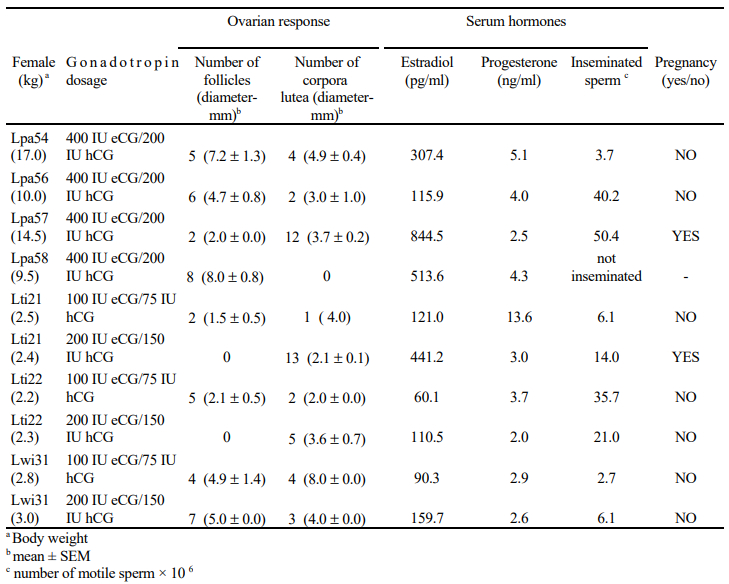Successful Artificial Insemination After Exogenous Gonadotropin Treatment in the Ocelot (Leopardus pardalis) and Tigrina (Leopardus tigrina)
1Criadouro de Animais Silvestres, Itaipu Binacional, Foz do Iguaçu, PR, Brazil; 2Setor de Ciências Biológicas, Universidade Federal do Paraná, Curitiba, PR, Brazil; 3Zoológico de Curitiba, Curitiba, PR, Brazil; 4Faculdade de Medicina Veterinária, Universidade de São Paulo, São Paulo, SP, Brazil; 5Conservation and Research Center, National Zoological Park, Smithsonian Institution, Front Royal, VA, USA
Abstract
The ocelot (Leopardus pardalis), margay (Leopardus wiedii) and tigrina (Leopardus tigrina), are three endangered South American small cat species whose long-term survival depends upon both in situ and ex situ conservation actions. Application of assisted reproductive technology, such as artificial insemination (AI) with fresh or frozen-thawed sperm, has considerable potential for improving captive propagation and management of endangered felids with low natural breeding success. Exchange of genetic material between captive and wild populations also could be achieved by these means. To date, offspring have been produced by laparoscopic AI in two small-sized nondomestic cat species, the leopard cat and the ocelot.2,3 In this study we assessed the feasibility of exogenous gonadotropin treatment and laparoscopic AI for inducing ovulation and producing offspring in wild-caught female margays, tigrinas and ocelots maintained at two institutions in southern Brazil. Females were treated with a sequential combination of equine chorionic gonadotropin (eCG) and human chorionic gonadotropin (hCG); hCG was administered 80 hr after eCG. Ocelots (n=4) were injected (i.m.) with 400 IU eCG/200 IU hCG whereas tigrinas (n=2) and a margay (n=1) received two treatments each of 100 IU eCG/75 IU hCG (September 1995) and 200 IU eCG/100 IU hCG (April 1996). Ovaries of each animal were evaluated laparoscopically 39–44 hr after hCG to determine number of unovulated follicles (≥2 mm) and corpora lutea.4 Blood samples were collected by jugular venipuncture and recovered sera were assessed for estradiol and progesterone concentrations using double-antibody 125I-estradiol and solid-phase 125I-progesterone radioimmunoassay kits (Diagnostic Products Corp., Los Angeles, CA). Females with recent ovulation sites (n=9) were inseminated in utero using fresh semen obtained by electroejaculation.1 Inseminated volume was 180–200:l (3.7–50.4x106 motile spermatozoa) in ocelots and 70–180 µl (2.7–35.7x106 motile spermatozoa) in margays and tigrinas. Number of ovarian structures, serum hormone levels and results of AI are presented for each female in Table 1. One female ocelot conceived and gave birth to six healthy kittens after a gestation period of 78 days. One tigrina also conceived and gave birth to three kittens after a 76 days gestation. These preliminary results suggest that tigrinas and margays, as previously reported for ocelots,2 are relatively insensitive to exogenous gonadotropins, requiring higher dosages (on a per body weight basis) than other cat species to induce follicular growth and ovulation. Nonetheless, two ovulating females became pregnant and carried offspring to term, representing the first successful artificial inseminations of nondomestic felids in Latin America and the first tigrina kittens produced by AI. In conclusion, although additional studies are needed to improve the efficiency of ovarian stimulation and increase conception rates, this AI technique has proven feasible to produce viable kittens in these small, endangered spotted cats. These findings suggest that laparoscopic AI may be useful as an adjunct to natural breeding for conservation of small Latin American felids.
Table 1. Ovarian responses, serum hormone concentrations and AI results in female ocelots (Lpa), tigrinas (Lti) and margays (Lwi) treated with exogenous gonadotropins and laparoscopically inseminated in utero

Acknowledgments
The authors thank the Curitiba Zoo and Itaipu Binacional for providing animals and assistance with sampling. This study was supported by Fundação de Amparo à Pesquisa do Estado de São Paulo (FAPESP), the New Opportunities in Animal Health Sciences (NOAHS) Center, Friends of National Zoo (FONZ), British Airways and The Philip Reed Foundation.
Literature Cited
1. Howard JG, Barone MA, Donoghue AM, Wildt DE. 1992. The effect of pre-ovulatory anesthesia on ovulation in laparoscopically inseminated domestic cats. J Repro Fert. 96:175–186.
2. Swanson WF, Howard JG, Roth TL, Brown JL, Alvarado T, Burton M, Starnes D, Wildt DE. 1996. Responsiveness of ovaries to exogenous gonadotropins and laparoscopic artificial insemination with frozen-thawed spermatozoa in ocelots (Felis pardalis). J Reprod Fert. 106:87–94.
3. Swanson WF, Wildt DE. 1997. Strategies and progress in reproductive research involving small cat species. Int Zoo Yearbook. In press.
4. Wildt DE, Kinney GM, Seager SWJ. 1977. Laparoscopy for direct observation of internal organs in the domestic cat and dog. Am J Vet Res. 38:1429–1432.